Reading about the early decades of Indian contemporary literature revealed to me that the short story form of creative writing gained traction among women writers in India because of its brevity and pithiness. Undertaking shorter pieces of work meant women were able to focus on their household duties and raising their children, rather than relinquishing traditional roles altogether to pursue creative paths.
Of course, that statement is highly reductive and attempts to radicalize the notion that early Indian women writers were simply responding to and negotiating, thereby accepting, the constructs of internalized misogyny and patriarchal social mores they were living with at the time. It devalues the revolutionary impact of their creative expression as many were tackling institutional and politicized issues concerning the role of women in Indian society, starting controversial conversations very much in tune with discourse that would become mainstream decades later.
Regardless, the thought stayed with me. I became interested in the connection form serves to fabrication and function, namely if and how the manifestation of the female narrative in the short story has changed from before the Partition to the present. Have the concerns of female protagonists, and the female authors of the Subcontinent that evoke(d) them, evolved over time?
I’ve selected six stories to consider — some popular, some controversial — written by renowned Indian women who’ve pioneered the literary world in India and abroad, with awareness that an illustrative few can only represent a larger discourse in some proportion. As it pertains to women and women’s literature, including these stories, the gaze is a problematic conception, arguably resting on a dialectic between acknowledgement (from seeing/being regarded) and denial (from dominance/control) — the pendulum shifting between ‘subject’ and ‘object’ in reflections of the other and society at large, and even the self.
1. Dilli ki Sair [A Visit to Delhi], Rashid Jahan (1932)
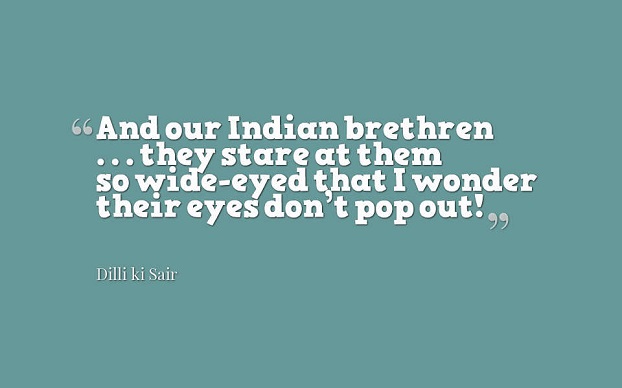
Rashid Jahan discloses her heroine on the veranda in the midst of a flocking of female neighbors, having just returned from a trip to Delhi full of scandalous revelations and eye-opening experiences. While the women are of a higher social class, general and unaccompanied movements are restricted, as the very act of traveling by train is the subject of awe.
The narrator confidently regales her audience of her forays into the world: a crowded train station in Delhi, where she was left alone to wait for her husband as he dallied with an old acquaintance. She shares her annoyance at her husband’s abandonment, but the boldness she exhibits in front of the other women pales in comparison to the fear she describes she felt amidst an unfamiliar and male-dominated outside world.
At the train station, male privilege gains gigantic proportions in the face of the narrator’s own shrinking frame, as she describes keeping to herself while sitting on the luggage and receiving jaunts from the men surrounding her. The safety and presence of women in public spaces and their subjection to the male gaze is paramount here, as is the vivid contrast between voice and silence, marking an interconnected parallel between the varying kinds of subjugation experienced by women in the domicile and public spheres. The reader is left contemplating not just the inside–outside boundaries of the physical lives of these women, but the limited constructs of selfhood within which they had the right to express themselves freely.
2. Lihaaf [The Quilt], by Ismat Chughtai (1942)
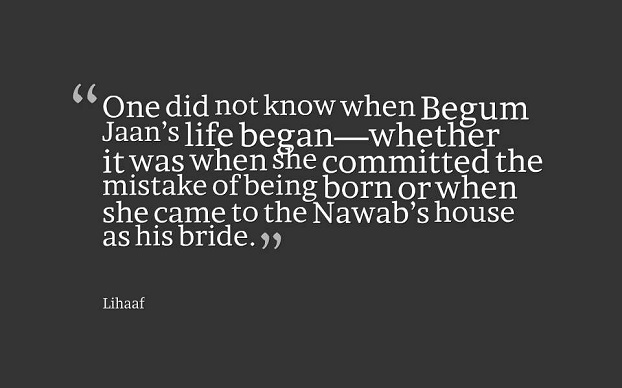
Traipsing the territories of the voiceless, Ismat Chughtai gives both women and children layered expression in Lihaaf. When her mother leaves town for Agra, a young girl moves into her step-aunt Begum Jaan’s home, whose troubled marriage to a nawab, or feudal lord, is revealed alongside the girl’s innocent fascination for her queenly aunt. Living in utter neglect of her mind and body, Begum Jaan’s own repressed passions and sexual tension are constantly under scrutiny by the girl, the other maids and the people of the public.
Later Begum Jaan is the subject of ridicule when she enters into an affair with her masseuse. Rabbu, a large, swelling woman is in all ways the anti-thesis of Begum Jaan. Rabbu takes to massaging Begum Jaan hour after hour, day after day, and in some time both Begum Jaan’s body and mannerisms appear to have transformed through her sexual awakening.
The more ‘masculine’ Begum Jaan becomes, the more the power dynamics around her change. The nawab is never heard of again in the story. In fact, Begum Jaan dons the role of excess, casting her empowerment in negative light especially as she takes to sexually abusing the little girl. But it is precisely Begum Jaan’s metaphorical transformation into dominance and masculinity that strips the reader’s earlier sympathies from her, thereby tackling the ever-problematic repression of female sexuality, child-like curiosity and homoeroticism in an inherently patriarchal society.
3. The Weed, by Amrita Pritam (1978)
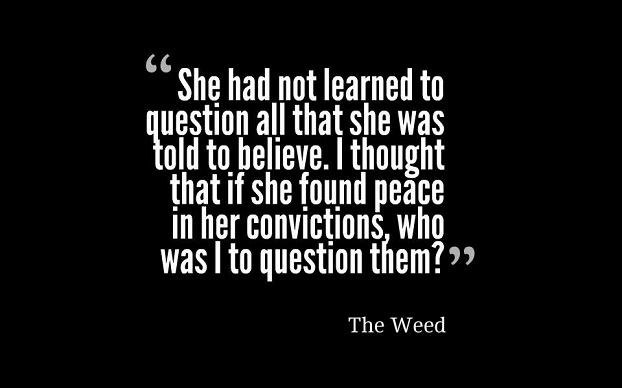
Translated from the Punjabi, Amrita Pritam’s The Weed reveals a new, then unprecedented kind of dissent: a clash of perspectives based on socio-economics within people, more so women, of the same culture. This drama unfolds between Bibi, an older woman and city-dweller, and Angoori, a young woman from the village who comes to the city to be with her much-older husband, Prabhati, who was hired help in Bibi’s neighbor’s home.
We receive descriptions of Angoori’s naivety — her superstitious beliefs, unintelligent interests, and her belief that it was a sin for women to read — through Bibi’s somewhat condescending perspective. Bibi takes some measure to distance herself from Angoori’s plebian ways, despite revealing a mutual sensitivity often shared in female interactions and relationships.
The story itself focuses on Angoori’s reverberations about a ‘wild weed’ which when consumed by a woman at the hands of man forces her to go ‘insane,’ to fall in love and choose her own lovers. Angoori, though trapped in a loveless marriage orchestrated by her father as a virgin and child bride, would rather maintain superficial sanctity than seek fulfillment.
However, we quickly learn Angoori is emotionally conflicted even without consuming the ‘weed’ because she has fallen for another man — and the metaphorical appeal of the title is suddenly self-evident. The ‘weed’ is human weakness, or naturalized tendency, which is unstoppable in its growth and must be addressed quickly, otherwise it stands to contaminate one’s being in the face of culturally accepted behaviors.
4. The Treatment of Bibi Haldar, Jhumpa Lahiri (1999)
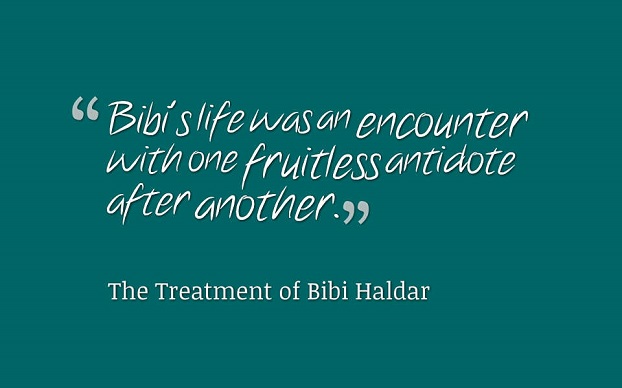
Jhumpa Lahiri’s oeuvre within the realm of the metaphor is often readable as equal parts allegorical and equal parts concrete. In the same vein Bibi Haldar’s ‘treatment’ referenced in the title has double entendre, and through the story we shift from one meaning (medical healing) to the other (conduct or handling). After losing both her parents Bibi finds herself living with her elder cousin and his wife in the storage room above their cosmetics shop in a small building in Calcutta. Having developed a mysterious illness in her youth which subjected Bibi to falling unconscious and bouts of delirium, it was not trusted that she could live by herself.
Soon it becomes apparent that Bibi’s illness has more of an abstract nature to it. Bibi, who is unprepared to become a wife in both her skill-sets and society’s standards of beauty, becomes overwhelmed with desperation for a man in her life. A doctor eventually diagnoses her paroxysms in light of Victorian-era ‘hysteria’ claiming that some activity of a sexual nature is all she needs to cure her. But when Bibi receives no proposals, she returns once again to her life of being ostracized, her now-pregnant cousins taking special means to segregate themselves from her ‘contagious’ condition.
One day, much to the shock of her neighbors, they discover she is pregnant — but there is no knowledge of assault or even a committed father. Her new condition is perhaps a hysterical pregnancy, ironically bearing the symptoms of ‘hysteria’ but, because of her role being more traditionally defined — from girl to mother, if not wife — she is declared as cured. The reader is left to speculate on has been Bibi’s illness all along: is it Bibi herself, or Indian society’s misled judgments that an unmarried woman of age is exceptionally flawed, even ‘insane’?
5. The Good Mother, Mridula Koshy (2009)
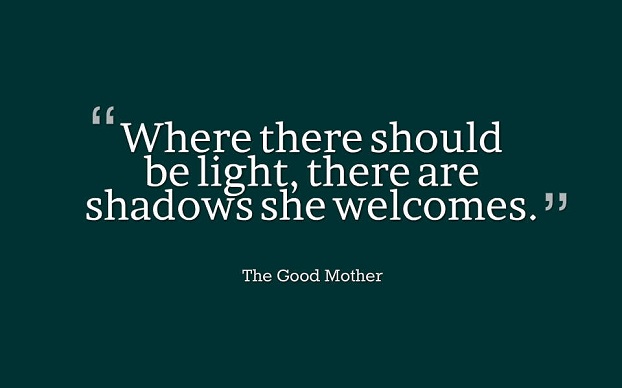
Though defined by the constructs of her motherhood, Mridula Koshy’s protagonist is less of a vehicle for female tropes and more of a multi-dimensional individual: a daughter, a traveler, a non-resident Indian and a lover. The various compositions of the narrator’s character lend the story a certain subjectivity, so much so her journey is as inward as it is an outward one.
The narrator visits her ailing parents filled with an emotional weight that suggests it is a turning point in her life. On the pretext of a heretofore-unnamed pilgrimage, she sets out for other cities, eventually making her way to Delhi with a younger man, Marc, whom she’d met on the way and taken on as a lover. Despite sexual fulfillment, death is constantly on the narrator’s mind — in the way she views the fleetingness of moments, sees death in the old age of her parents, recalls her sons who are, in fact, dead.
She finds herself returned to a state of compromise, of having to negotiate with reality in order to make peace with it, and on the balcony of their small flat she tosses out her sons’ ashes into the wind, making a wish that their dreams still come true. She refers to all other aspects of herself as ‘foolishness,’ a farce, in the end her identity resuming its primary definition, drawn from reflecting on the idealized, perfected versions of womanhood, including those of being a ‘good mother.’
6. The Domestic Maid, Anita Desai (2014)
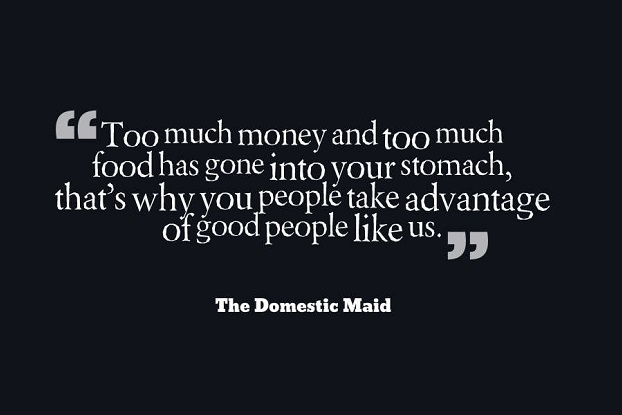
Anita Desai’s story highlights the dialogical inconsistencies, and dependencies, between urban and rural life. In the high-rise residential buildings of a gentrified middle-class neighborhood, we are introduced to a group of part-time maids who service multiple employers in order to supplement their family incomes, and at the end of the day return home to take care of their husbands and children.
Geeta, one such maid, laments about her employer’s inability to sympathize with her reasons for being late to work — a visit to the hospital to tend to her wounds from her husband’s beating the night before — since Asha, her employer, had derided her for being a cheat instead. Standing in Asha’s living room, Geeta’s impoverishment is revealed in stark contrast to her employer’s cushy life, and though there are domestic aspects to Asha’s identity which she cannot escape either, it is evident that progress is limited to those who can afford it. Though they are all ‘working women,’ these aspects of progress regress into the background of a new power struggle, one that is largely defined by economics.
Later Geeta’s friend Chaaya alerts her to the possibility of Asha’s own frustrations and re-evaluates the power politics of the situation. Chaaya’s empathy evens the playing field, reinforcing that the traditional aspects of womanhood are common to all, such as raising a family, maintaining a work–life balance, dealing with in-laws etc. But in her doing so the reader speculates on the amount of progress women like Asha have truly made in transforming the expectations society has of them. Even in terms of personal development, while Asha’s poor attitude is freeing of supposed standards of womanly virtue, one also questions whether economic development, without the evolution of mindsets and ethos, truly counts as progress.
***
Thus, the complex layers that emerge from these stories are a result of both internal and external conflicts, which grant these female characters multi-dimensionality and density, helping their narratives traverse the gap from being an object of study to a complete subject in themselves. But contextually speaking, the nuances of these predicaments vary in focus and vociferousness, especially in the well-roundedness of the female character’s interiority and the access one has to her personal motivations, reflections and opinions.
Operating within the reasonable assumption that Indian society, despite its still-current flaws and all, has progressed and modernized to some extent, it seems the restrictions of domesticity and societal pressures faced by Indian women has largely been hard to shake. While the subject–object boundaries of female narrative have renewed shape in the kinds of stories that are told, how they are told and how they are read, I wonder whether the same can be said of the inside–outside boundaries that outline physical empowerment and practical movement.
For example, Rashid Jahan’s exemplification of the disconcertedness of being a woman alone in a male-dominated crowd in Delhi in 1932 is valid to this day — as a native of Delhi, I can even vouch for it. In fact, movements continue to be limited literally and figuratively, in oppressive pre-determinations of what it means to be a ‘good’ and ‘pure’ and ‘virtuous’ woman, and identity labels that can be extended only when traditional roles are fulfilled, as Koshy and Desai illustrate decades later.
Thus, the circumstances surrounding the women in these stories continue to be dominated by external culture, even if their personal subjectivity has evolved. The post-modern deconstruction of culture has broken down consolidated narrative — that of the ‘Indian Woman’ — into particularized narrative, meaning depending on various factors Indian women experience and negotiate different aspects of their cultures. But it is evident that the struggle to transcend the restrictions imposed upon them by society on the whole, to be truly free of pre-determinations and objectification, is a potent history carried up to this day.
***
A patron of knowledge-seeking, the arts and the academy, Dipti’s path on the road of authorpreneurship includes studying entrepreneurship at Babson College, philosophy, literary theory and comparative literature at NYU, and a creative writing stint at Oxford University. She has worked as an editor at Penguin Random House India as well as small press journals. A poet, essayist and short story writer, Dipti lives in New Delhi, India, and is currently working on her debut novel. To be in touch, visit www.diptianand.com.












